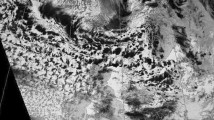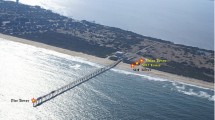Abstract
We present measurements from 2006 of the marine wind speed profile at a site located 18 km from the west coast of Denmark in the North Sea. Measurements from mast-mounted cup anemometers up to a height of 45 m are extended to 161 m using LiDAR observations. Atmospheric turbulent flux measurements performed in 2004 with a sonic anemometer are compared to a bulk Richardson number formulation of the atmospheric stability. This is used to classify the LiDAR/cup wind speed profiles into atmospheric stability classes. The observations are compared to a simplified model for the wind speed profile that accounts for the effect of the boundary-layer height. For unstable and neutral atmospheric conditions the boundary-layer height could be neglected, whereas for stable conditions it is comparable to the measuring heights and therefore essential to include. It is interesting to note that, although it is derived from a different physical approach, the simplified wind speed profile conforms to the traditional expressions of the surface layer when the effect of the boundary-layer height is neglected.
Similar content being viewed by others
References
Antoniou I, Jørgensen HE, Mikkelsen T, Frandsen S, Barthelmie R, Perstrup C, Hurtig M (2006) Offshore wind profile measurements from remote sensing instruments. In: Proceedings of the European Wind Energy Conference. European Wind Energy Association, Athens. (http://www.ewec2006proceedings.info/allfiles2/267_Ewec2006fullpaper.pdf)
Blackadar AK (1962) The vertical distribution of wind and turbulent exchange in a neutral atmosphere. J Geophys Res 67: 3095–3102
Busch NE, Panofsky HA (1968) Recent spectra of atmospheric turbulence. Q J Roy Meteorol Soc 94: 361–379
Businger JA, Wyngaard JC, Izumi Y, Bradley EF (1971) Flux-profile relationships in the atmospheric surface layer. J Atmos Sci 28: 181–189
Carl DM, Tarbell TC, Panofsky HA (1973) Profiles of wind and temperature from towers over homogeneous terrain. J Atmos Sci 30: 788–794
Charnock H (1955) Wind stress over a water surface. Q J Roy Meteorol Soc 81: 639–640
Christiansen MB, Koch W, Hortsmann J, Hasager CB (2006) Wind resource assessment from C-band SAR. Remote Sens Environ 105: 68–81
Dyer AJ (1974) A review of flux-profile relationships. Boundary-Layer Meteorol 7: 363–372
Emeis S, Harris M, Banta RM (2007) Boundary-layer anemometry by optical remote sensing for wind energy applications. Meteorol Z 16(4): 337–347
Garratt JR (1977) Review of drag coefficients over oceans and continents. Mon Wea Rev 105: 915–929
Grachev AA, Fairall CW (1996) Dependence of the Monin-Obukhov stability parameter on the bulk Richardson number over the ocean. J Appl Meteorol 36: 406–414
Grachev AA, Fairall CW, Bradley EF (2000) Convective profile constraints revisited. Boundary-Layer Meteorol 94: 495–515
Gryning S-E, Batchvarova E (2002) Marine boundary layer and turbulent fluxes over the Baltic Sea: measurements and modelling. Boundary-Layer Meteorol 103: 29–47
Gryning S-E, Holtslag AAM, Irwin JS, Sivertsen B (1987) Applied dispersion modelling based on meteorological scaling parameters. Atmos Environ 21: 79–89
Gryning S-E, Batchvarova E, Brümmer B, Jørgensen H, Larsen S (2007) On the extension of the wind profile over homogeneous terrain beyond the surface layer. Boundary-Layer Meteorol 124: 251–268
Högström U (1988) Non-dimensional wind and temperature profiles in the atmospheric surface layer: a re-evaluation. Boundary-Layer Meteorol 42: 55–78
Högström U, Smedman A-S, Bergström H (2006) Calculation of wind speed variation with height over the sea. Wind Eng 30: 269–286
Høyer JL, She J (2007) Optimal interpolation of sea surface temperature for the North Sea and the Baltic Sea. J Mar Syst 65: 176–189
Kaimal JC, Gaynor JE (1991) Another look at sonic thermometry. Boundary-Layer Meteorol 56: 401–410
Kindler D, Oldroyd A, MacAskill A, Finch D (2007) An eight month test campaign of the Qinetiq ZephIR system: preliminary results. Meteorol Z 16(5): 479–489
Kraus EB (1972) Atmosphere-Ocean interaction. Oxford University Press, London, p 275 pp
Lange B, Larsen S, Højstrup J, Barthelmie R (2004) Importance of thermal effects and the sea surface roughness for offshore wind resource assessment. J Wind Eng Ind Aerodyn 92: 959–988
Mann J, Dellwik E, Bingöl F, Rathmann O (2007) Laser measurements of flow over a forest. J Phys: Conf Ser 75:012057 (7 pp)
Niros A, Vihma T, Launiainen J (2002) Marine meteorological conditions and air-sea exchange processes over Northern Baltic Sea in 1990s. Geophysica 38: 59–88
Panofsky HA (1973) Tower micrometeorogy. In: Haugeb DA (ed) Workshop on micrometeorolgy. American Meteorology Society, pp 151–176
Peña A, Gryning S-E (2008) Charnock’s roughness length model and non-dimensional wind profiles over the sea. Boundary-Layer Meteorol 128: 191–203
Peña A, Hasager CB, Gryning S-E, Courtney M, Antoniou I, Mikkelsen T (2008) Offshore wind profiling using light detection and ranging measurements. Wind Energy. doi:10.1002/we.283
Rossby CG, Montgomery RB (1935) The layers of frictional influence in wind and ocean currents. Pap Phys Oceanogr Meteorol 3(3): 101
Seibert P, Beyrich F, Gryning S-E, Joffre S, Rasmussen A, Tercier P (2000) Review and intercomparison of operational methods for the determination of the mixing height. Atmos Environ 34: 1001–1027
Smith DA, Harris M, Coffey AS, Mikkelsen T, Jørgensen HE, Mann J, Danielian R (2006) Wind lidar evaluation at the Danish wind test site in Høvsøre. Wind Energy 9: 87–93
Stull RB (1988) An introduction to boundary layer meteorology. Kluwer Academic Publishers, Dordrecht, p 666
Tennekes H (1973) The logarithmic wind profile. J Atmos Sci 30: 234–238
Webb EK (1970) Profile relationships: the log-linear range, and extension to strong stability. Q J Roy Meteorol Soc 96: 67–90
Author information
Authors and Affiliations
Corresponding author
Rights and permissions
About this article
Cite this article
Peña, A., Gryning, SE. & Hasager, C.B. Measurements and Modelling of the Wind Speed Profile in the Marine Atmospheric Boundary Layer. Boundary-Layer Meteorol 129, 479–495 (2008). https://doi.org/10.1007/s10546-008-9323-9
Received:
Accepted:
Published:
Issue Date:
DOI: https://doi.org/10.1007/s10546-008-9323-9




